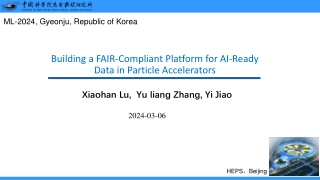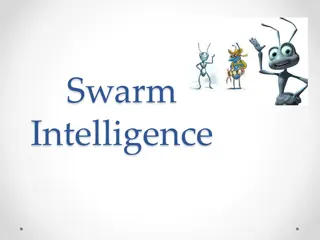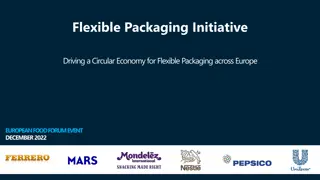Silicon Tracking with GENFIT - Optimization for Reliable and Flexible Particle Detector Data Analysis
Framework for particle tracking, GENFIT, offers robust and flexible features for diverse detector types, fitting algorithms, and track parameterizations. It enables reliable data analysis for various experiments requiring accuracy and adaptability, with an easy-to-debug nature.
Download Presentation

Please find below an Image/Link to download the presentation.
The content on the website is provided AS IS for your information and personal use only. It may not be sold, licensed, or shared on other websites without obtaining consent from the author.If you encounter any issues during the download, it is possible that the publisher has removed the file from their server.
You are allowed to download the files provided on this website for personal or commercial use, subject to the condition that they are used lawfully. All files are the property of their respective owners.
The content on the website is provided AS IS for your information and personal use only. It may not be sold, licensed, or shared on other websites without obtaining consent from the author.
E N D
Presentation Transcript
Silicon Tracking with GENFIT Zhang Yao 29 August 2016 CEPC Physics Software Meeting
Motivation of tracking study Optimization of SID and future application Requirements Robust : can give reliable efficiency and resolution Flexible : adapt to different detector design independent : insensitive to the constantly changed geometry and data format Easy to debug and validation Status ILC (Vertex and TCP based) tracking --- quickly verify Standalone track fitting toolkit (GENFIT) --- crosscheck 2025/2/24 CEPC Physics Software Meeting 2
Introduction to GENFIT The trend to use a toolkit for tracking which is independent and can be used in a wide range of experiments The generic toolkits have been developed to meet this challenges, such as GENFIT* and RecPack** GENFIT is a novel framework for track fitting First Developed as part of the PANDA framework and now distributed as a stand- alone package Used by recent HEP experiment such as BelleII Written in C++,modular and highly object oriented design * NIM A, Vol 620, 518-525 (2010), Code http://sourceforge.net/projects/genfit/ ** NIM A, Vol 534 180 183 (2004) 2025/2/24 CEPC Physics Software Meeting 3
Features of GENFIT(1) Can treat several types of detectors 1. silicon strip detectors or multiwire proportional chambers 2. silicon pixel detectors 3. drift chambers or straw tubes 4. TPC 5. Stations of several planes of category 1 and 2, or electromagnetic calorimeters Hits are defined in detector planes: 1D for strips/wires, 2D for pixels, virtual detector planes in the case of drift tubes, TPC 2025/2/24 CEPC Physics Software Meeting 4
Features of GENFIT(2) Fitting algorithms can be easily implemented Validated Kalman filter Deterministic Annealing Filter (DAF) Gaussian sum filters Extrapolations method Runge-Kutta invoke of external libraries , such as GENAE Simultaneous fitting of several tracks to the same set of hits Optimize track parameterizations and extrapolation different phase space regions with different track models fit different mass hypotheses 2025/2/24 CEPC Physics Software Meeting 5
Fitting implementation Material Get from GDML file generated by simulation A TGeo(ROOT) object is encapsulated in the track representations Detector geometry Geometry interface not implemented Magnetic field Constant field with B=(0, 0 ,3.5)Tesla Read track(s) from truth Initial position and initial momentum Read hits from truth Cell id or Position Momentum of each hit (to define virtual detector plane) 2025/2/24 CEPC Physics Software Meeting 6
Fitting flow Create track Create initial with track from MC truth Smear the start position and momentum Create the track representation with mass hypothesis Add measurements on track Create a space point truth hit position coming from particle Smear hit (digitization) Smear pixel measurement with gauss at (r-phi, z)=0.02x0.02 mm for both barrel and endcap Smear strip measurement with gauss at (r-phi, z)= 0.05x0.1 mm for both barrel and endcap Create virtual detector plane by the plane perpendicular to momentum direction at this hit Put detector resolution : 1/sqrt(12) * detector element width fit track with DAF (Deterministic Annealing Filter ) 2025/2/24 CEPC Physics Software Meeting 7
First fit result 10GeV muon Initial track and hits not smeared Preliminary Fit momentum truth momentum(GeV/c) 2025/2/24 CEPC Physics Software Meeting 8
Future plane Geometry requirement For a given cell knows the direction of boundaries for each detector element Solution: 1. geometry toolkit 2. get detector plane vector saved with ROOT format Magnetic field Reading filed map (get field vector of specified position) Measurement fitting Form fit space point to fit a measurement in defined detector plane Migrate to Marlin Use VirtuleBox and mini Marlin as development environment Start from TruthTracker(create rec. track from MC truth) in Marlin Read cluster, hit and track from track finding Convert track to LCIO representation 2025/2/24 CEPC Physics Software Meeting 9
Summary and Outlook A generic track fitting toolkit---GENFIT is preliminary implemented for SID fitting Resolution and tail events should be checked More work on integration in Marlin framework Geometry interface Measurement on detector plane Using track finding results Track IO Track finding proposal Hough finding or combinational Kalman filtering Neural Network or Machine learning 2025/2/24 CEPC Physics Software Meeting 10




